Cheng-Xiang Wang
Sherman
Large-Model AI for Near Field Beam Prediction: A CNN-GPT2 Framework for 6G XL-MIMO
Oct 26, 2025Abstract:The emergence of extremely large-scale antenna arrays (ELAA) in millimeter-wave (mmWave) communications, particularly in high-mobility scenarios, highlights the importance of near-field beam prediction. Unlike the conventional far-field assumption, near-field beam prediction requires codebooks that jointly sample the angular and distance domains, which leads to a dramatic increase in pilot overhead. Moreover, unlike the far- field case where the optimal beam evolution is temporally smooth, the optimal near-field beam index exhibits abrupt and nonlinear dynamics due to its joint dependence on user angle and distance, posing significant challenges for temporal modeling. To address these challenges, we propose a novel Convolutional Neural Network-Generative Pre-trained Transformer 2 (CNN-GPT2) based near-field beam prediction framework. Specifically, an uplink pilot transmission strategy is designed to enable efficient channel probing through widebeam analog precoding and frequency-varying digital precoding. The received pilot signals are preprocessed and passed through a CNN-based feature extractor, followed by a GPT-2 model that captures temporal dependencies across multiple frames and directly predicts the near-field beam index in an end-to-end manner.
CKMDiff: A Generative Diffusion Model for CKM Construction via Inverse Problems with Learned Priors
Apr 24, 2025Abstract:Channel knowledge map (CKM) is a promising technology to enable environment-aware wireless communications and sensing with greatly enhanced performance, by offering location-specific channel prior information for future wireless networks. One fundamental problem for CKM-enabled wireless systems lies in how to construct high-quality and complete CKM for all locations of interest, based on only limited and noisy on-site channel knowledge data. This problem resembles the long-standing ill-posed inverse problem, which tries to infer from a set of limited and noisy observations the cause factors that produced them. By utilizing the recent advances of solving inverse problems with learned priors using generative artificial intelligence (AI), we propose CKMDiff, a conditional diffusion model that can be applied to perform various tasks for CKM constructions such as denoising, inpainting, and super-resolution, without having to know the physical environment maps or transceiver locations. Furthermore, we propose an environment-aware data augmentation mechanism to enhance the model's ability to learn implicit relations between electromagnetic propagation patterns and spatial-geometric features. Extensive numerical results are provided based on the CKMImageNet and RadioMapSeer datasets, which demonstrate that the proposed CKMDiff achieves state-of-the-art performance, outperforming various benchmark methods.
Low-Complexity Iterative Precoding Design for Near-field Multiuser Systems With Spatial Non-Stationarity
Jan 18, 2025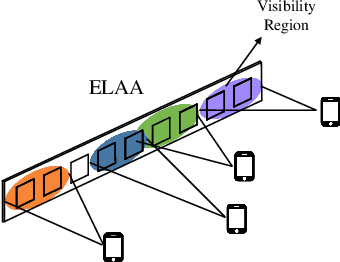


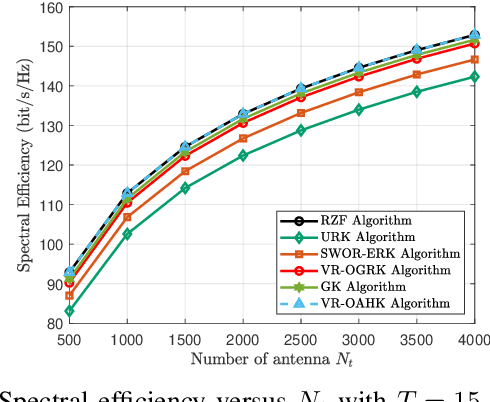
Abstract:Extremely large antenna arrays (ELAA) are regarded as a promising technology for supporting sixth-generation (6G) networks. However, the large number of antennas significantly increases the computational complexity in precoding design, even for linearly regularized zero-forcing (RZF) precoding. To address this issue, a series of low-complexity iterative precoding are investigated. The main idea of these methods is to avoid matrix inversion of RZF precoding. Specifically, RZF precoding is equivalent to a system of linear equations that can be solved by fast iterative algorithms, such as random Kaczmarz (RK) algorithm. Yet, the performance of RK-based precoding algorithm is limited by the energy distributions of multiple users, which restricts its application in ELAA-assisted systems. To accelerate the RK-based precoding, we introduce the greedy random Kaczmarz (GRK)-based precoding by using the greedy criterion-based selection strategy. To further reduce the complexity of the GRK-based precoding, we propose a visibility region (VR)-based orthogonal GRK (VR-OGRK) precoding that leverages near-field spatial non-stationarity, which is characterized by the concept of VR. Next, by utilizing the information from multiple hyperplanes in each iteration, we extend the GRK-based precoding to the aggregation hyperplane Kaczmarz (AHK)-based pecoding algorithm, which further enhances the convergence rate. Building upon the AHK algorithm, we propose a VR-based orthogonal AHK (VR-OAHK) precoding to further reduce the computational complexity. Furthermore, the proposed iterative precoding algorithms are proven to converge to RZF globally at an exponential rate. Simulation results show that the proposed algorithms achieve faster convergence and lower computational complexity than benchmark algorithms, and yield very similar performance to the RZF precoding.
An Efficient Pre-Processing Method for 6G Dynamic Ray-Tracing Channel Modeling
Jan 06, 2025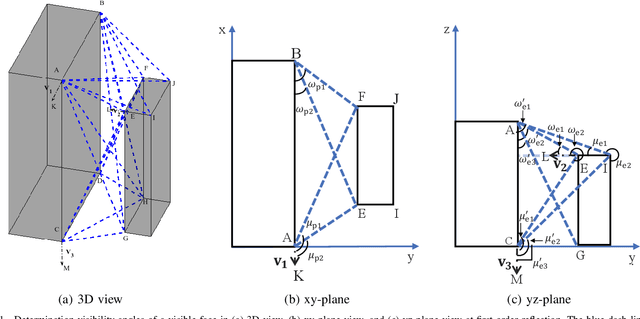
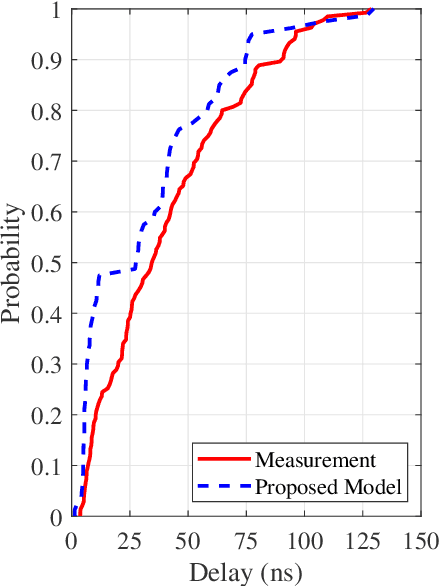
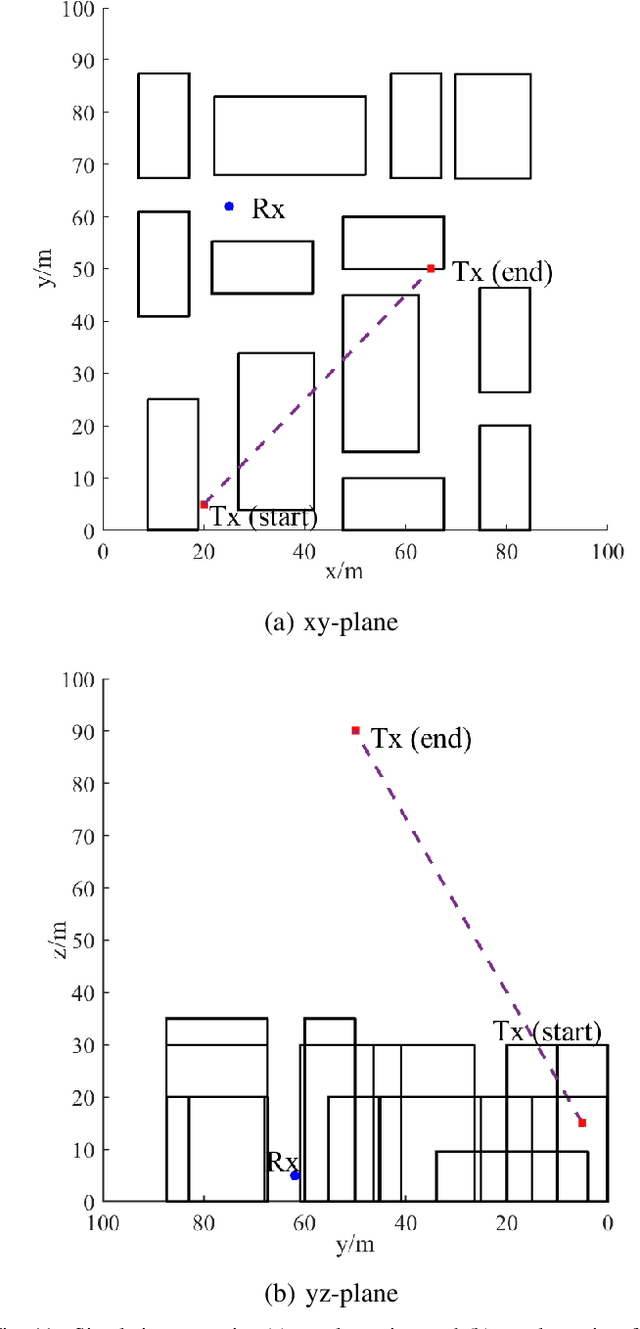
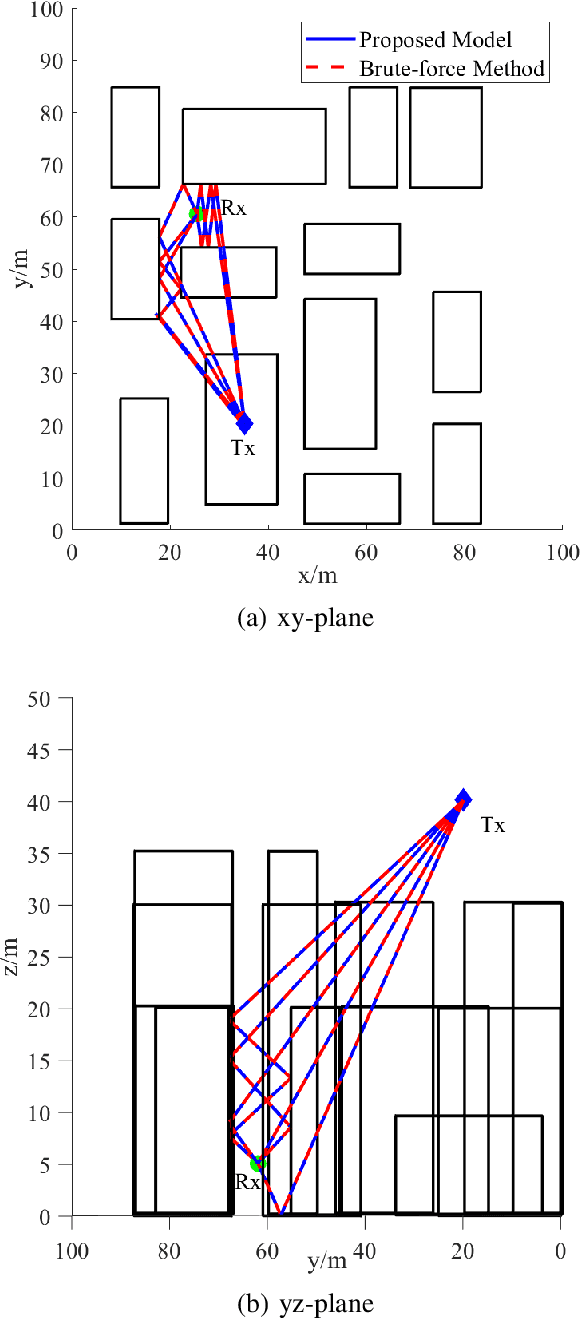
Abstract:The ray-tracing is often employed in urban areas for channel modeling with high accuracy but encounters a substantial computational complexity for high mobility scenarios. In this paper, we propose a novel pre-processing method for dynamic ray-tracing to reduce the computational burden in high-mobility scenarios by prepending the intersection judgment to the pre-processing stage. The proposed method generates an inter-visibility matrix that establishes visibility relationships among static objects in the environment considering the intersection judgment. Moreover, the inter-visibility matrix can be employed to create the inter-visibility table for mobile transmitters and receivers, which can improve the efficiency of constructing an image tree for the three-dimensional (3D) dynamic ray-tracing method. The results show that the proposed pre-processing method in dynamic ray-tracing has considerable time-saving compared with the traditional method while maintaining the same accuracy. The channel characteristics computed by the proposed method can well match to the channel measurements.
LinFormer: A Linear-based Lightweight Transformer Architecture For Time-Aware MIMO Channel Prediction
Oct 28, 2024



Abstract:The emergence of 6th generation (6G) mobile networks brings new challenges in supporting high-mobility communications, particularly in addressing the issue of channel aging. While existing channel prediction methods offer improved accuracy at the expense of increased computational complexity, limiting their practical application in mobile networks. To address these challenges, we present LinFormer, an innovative channel prediction framework based on a scalable, all-linear, encoder-only Transformer model. Our approach, inspired by natural language processing (NLP) models such as BERT, adapts an encoder-only architecture specifically for channel prediction tasks. We propose replacing the computationally intensive attention mechanism commonly used in Transformers with a time-aware multi-layer perceptron (TMLP), significantly reducing computational demands. The inherent time awareness of TMLP module makes it particularly suitable for channel prediction tasks. We enhance LinFormer's training process by employing a weighted mean squared error loss (WMSELoss) function and data augmentation techniques, leveraging larger, readily available communication datasets. Our approach achieves a substantial reduction in computational complexity while maintaining high prediction accuracy, making it more suitable for deployment in cost-effective base stations (BS). Comprehensive experiments using both simulated and measured data demonstrate that LinFormer outperforms existing methods across various mobility scenarios, offering a promising solution for future wireless communication systems.
Optimizing Air-borne Network-in-a-box Deployment for Efficient Remote Coverage
Jun 04, 2024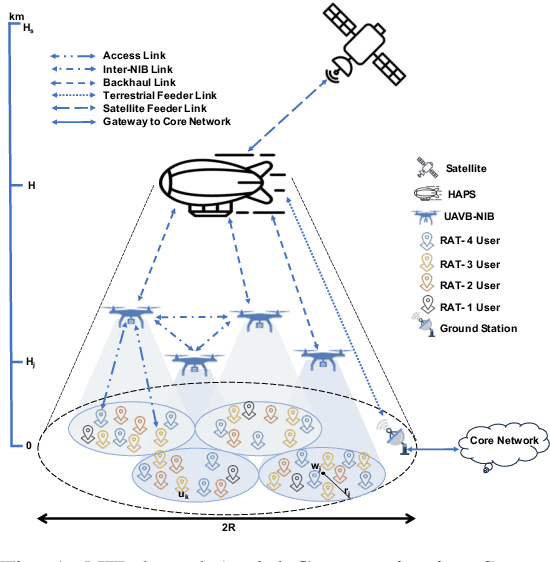
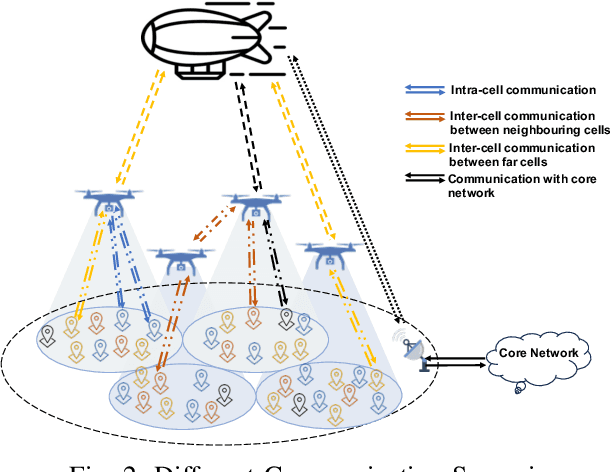
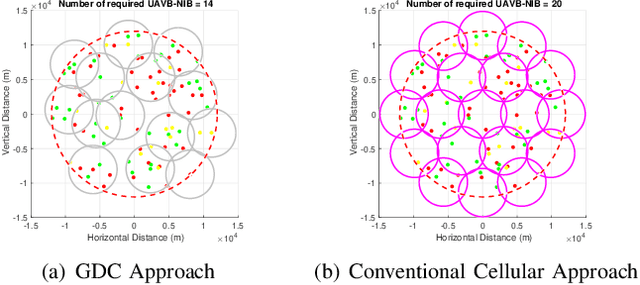

Abstract:Among many envisaged drivers for the sixth generation, one is from the United Nations Sustainability Development Goals 2030 to eliminate digital inequality. Remote coverage in sparsely populated areas, difficult terrains, or emergency scenarios requires on-demand access and flexible deployment with minimal capex and opex. In this context, network-in-a-box (NIB) is an exciting solution that packs the whole wireless network into a single portable and re-configurable box to support multiple access technologies such as WiFi/2G/3G/4G/5G etc. In this paper, we propose low-altitude platform stations (LAPS) based NIBs with stratospheric high-altitude platform station (HAPS) as backhaul. Specifically, backhaul employs non-orthogonal multiple access (NOMA) with superposition coding at the transmitting HAPS and successive interference cancellation (SIC) at the receiving NIBs, whereas the access link (AL) employs superposition coding along with the regularized zero-forcing (RZF) precoding at the NIB in order to elevate the computational overhead from the ground users. The required number of airborne NIBs to serve a desired coverage area, their optimal placement, user association, beam optimization, and resource allocation are optimized by maximizing the sum rate of the AL while maintaining the quality of service. Our findings reveal the significance of thorough system planning and communication parameters optimization for enhanced system performance and best coverage under limited resources.
NMBEnet: Efficient Near-field mmWave Beam Training for Multiuser OFDM Systems Using Sub-6 GHz Pilots
Apr 23, 2024



Abstract:Combining millimetre-wave (mmWave) communications with an extremely large-scale antenna array (ELAA) presents a promising avenue for meeting the spectral efficiency demands of the future sixth generation (6G) mobile communications. However, beam training for mmWave ELAA systems is challenged by excessive pilot overheads as well as insufficient accuracy, as the huge near-field codebook has to be accounted for. In this paper, inspired by the similarity between far-field sub-6 GHz channels and near-field mmWave channels, we propose to leverage sub-6 GHz uplink pilot signals to directly estimate the optimal near-field mmWave codeword, which aims to reduce pilot overhead and bypass the channel estimation. Moreover, we adopt deep learning to perform this dual mapping function, i.e., sub-6 GHz to mmWave, far-field to near-field, and a novel neural network structure called NMBEnet is designed to enhance the precision of beam training. Specifically, when considering the orthogonal frequency division multiplexing (OFDM) communication scenarios with high user density, correlations arise both between signals from different users and between signals from different subcarriers. Accordingly, the convolutional neural network (CNN) module and graph neural network (GNN) module included in the proposed NMBEnet can leverage these two correlations to further enhance the precision of beam training.
Exploit High-Dimensional RIS Information to Localization: What Is the Impact of Faulty Element?
Mar 25, 2024



Abstract:This paper proposes a novel localization algorithm using the reconfigurable intelligent surface (RIS) received signal, i.e., RIS information. Compared with BS received signal, i.e., BS information, RIS information offers higher dimension and richer feature set, thereby providing an enhanced capacity to distinguish positions of the mobile users (MUs). Additionally, we address a practical scenario where RIS contains some unknown (number and places) faulty elements that cannot receive signals. Initially, we employ transfer learning to design a two-phase transfer learning (TPTL) algorithm, designed for accurate detection of faulty elements. Then our objective is to regain the information lost from the faulty elements and reconstruct the complete high-dimensional RIS information for localization. To this end, we propose a transfer-enhanced dual-stage (TEDS) algorithm. In \emph{Stage I}, we integrate the CNN and variational autoencoder (VAE) to obtain the RIS information, which in \emph{Stage II}, is input to the transferred DenseNet 121 to estimate the location of the MU. To gain more insight, we propose an alternative algorithm named transfer-enhanced direct fingerprint (TEDF) algorithm which only requires the BS information. The comparison between TEDS and TEDF reveals the effectiveness of faulty element detection and the benefits of utilizing the high-dimensional RIS information for localization. Besides, our empirical results demonstrate that the performance of the localization algorithm is dominated by the high-dimensional RIS information and is robust to unoptimized phase shifts and signal-to-noise ratio (SNR).
Performance Analysis on RIS-Aided Wideband Massive MIMO OFDM Systems with Low-Resolution ADCs
Mar 14, 2024Abstract:This paper investigates a reconfigurable intelligent surface (RIS)-aided wideband massive multiple-input multiple-output (MIMO) orthogonal frequency division multiplexing (OFDM) system with low-resolution analog-to-digital converters (ADCs). Frequency-selective Rician fading channels are considered, and the OFDM data transmission process is presented in time domain. This paper derives the closed-form approximate expression of the uplink achievable rate, based on which the asymptotic system performance is analyzed when the number of the antennas at the base station and the number of reflecting elements at the RIS grow to infinity. Besides, the power scaling laws of the considered system are revealed to provide energy-saving insights. Furthermore, this paper proposes a gradient ascent-based algorithm to design the phase shifts of the RIS for maximizing the minimum user rate. Finally, numerical results are presented to verify the correctness of analytical conclusions and draw insights.
Electromagnetic Information Theory: Fundamentals and Applications for 6G Wireless Communication Systems
Jan 17, 2024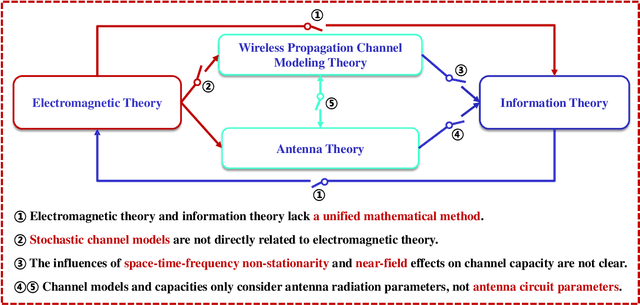
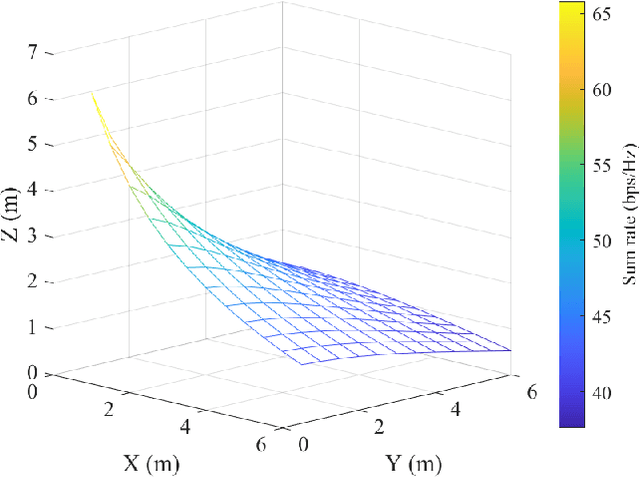
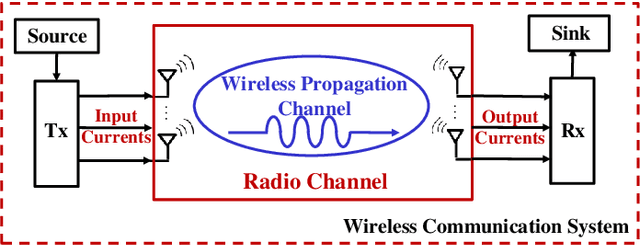
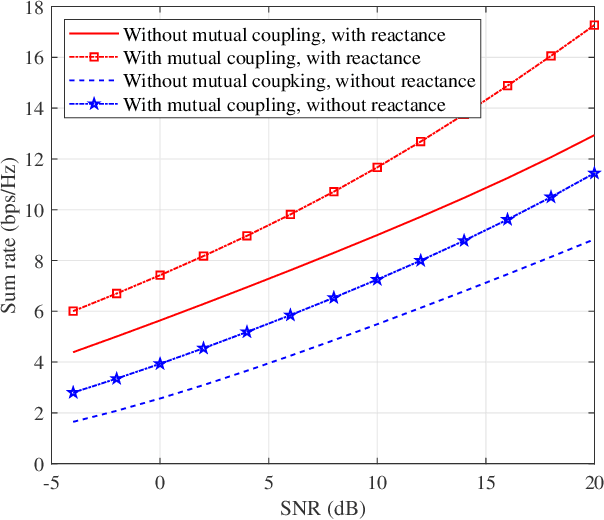
Abstract:In wireless communications, electromagnetic theory and information theory constitute a pair of fundamental theories, bridged by antenna theory and wireless propagation channel modeling theory. Up to the fifth generation (5G) wireless communication networks, these four theories have been developing relatively independently. However, in sixth generation (6G) space-air-ground-sea wireless communication networks, seamless coverage is expected in the three-dimensional (3D) space, potentially necessitating the acquisition of channel state information (CSI) and channel capacity calculation at anywhere and any time. Additionally, the key 6G technologies such as ultra-massive multiple-input multiple-output (MIMO) and holographic MIMO achieves intricate interaction of the antennas and wireless propagation environments, which necessitates the joint modeling of antennas and wireless propagation channels. To address the challenges in 6G, the integration of the above four theories becomes inevitable, leading to the concept of the so-called electromagnetic information theory (EIT). In this article, a suite of 6G key technologies is highlighted. Then, the concepts and relationships of the four theories are unveiled. Finally, the necessity and benefits of integrating them into the EIT are revealed.
 Add to Chrome
Add to Chrome Add to Firefox
Add to Firefox Add to Edge
Add to Edge